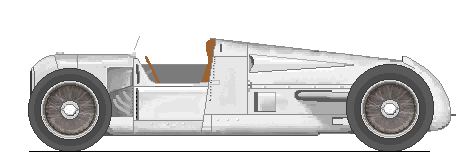
Auto Union 1934 ("A")
| Grand Prix 750 kg |
| Design: | Ferdinand Porsche |
| Engine: | V16 45°, 68 * 75 mm = 4358cc, 2 valves/cyl, Roots supercharger, 295 bhp @ 4500 rpm |
| Transmission: | 5 speed gearbox |
| Chassis: | tubular frame |
| Suspension: | front: independent with trailing links, torsion bars, friction dampers |
| rear: swing axles, transverse leaf springs, friction dampers |
| Dimensions: | wheelbase: 280 cm, track: 139/139 cm, weight: 825 kg dry |
| Year: | 1934, cars built: 5 |
Starting off as the Porsche "P-wagen" the official name of the car was T 22 and it has later been
called type A or type 1934.
The chassis composed of two 75mm diameter chrome nickel molybdenum steel
tubes with upswept front ends interlinked ladder fashion by four tubular cross
members.
The independent front suspension consisted of two trailing arms for each wheel, the lower one
being connected to a 16mm torsion bar. The torsion bars were set laterally within
the front cross tube, connecting to trailing links supporting the hub carriers. The
rear suspension consisted of a swing axle with a transverse mounted leaf spring.
The steering box was centrally mounted with the steering column being offset 2.5
deg to the right. The 42 cm steering wheel was detatchable.
Brakes were drums type Lockheed on all four wheels.
The V16 engine was of a simple and straightforward design aimed to achieve the
greatest possible power and torque per weight rather than per liter. The cylinders
were arranged in two banks in a 45° angle. Each cylinder had two valves placed at
90° and a single plug, slightly offline from the center. The 45° concept made it
possible to use a single camshaft in the middle of the vee for all 32 valves working
straight on the inlet valves and on the exhaust valves with pushrods.
Engine featured detachable cylinder heads and wet type cylinder liners.The
pistons were light alloy. The one piece crankshaft ran in lead-bronze main bearings.
The big ends too were plain. Lubrication was of dry sump type.
A single Roots supercharger mounted vertically behind the block was gear driven
off the camdrive. It delivered mixture drawn from two Solex carburettors at 1.66
ata boost.
The V16 was slow reving but the mid range torque was an impressive 54 *9.81 = 530 Nm at
2700 rpm.
The gearbox was mounted behind the rear axle, a short shaft passing under the
differential connected it with the cluch mounted behind the engine.
The main fuel tank was mounted between the driver seat and the engine.
The radiator was mounted in the front and included an oil cooler at the bottom.
The frame was used to carry water to the radiator. That later proved to be a troublesome feature.
As a consequence of the mid engine design the driver was placed far forward, his
feets being just behind the centre line of the front wheels. The lack of drive shaft made
him to sit low. The 170 liter main tank was behind him and a 40 liter reserve tank
was over his feet. The refuelling shaft was on the right side.
Both tanks were well within the wheelbase and so minimized handling changes
during a long race. The fuel capacity was selected to do even the longest GP
with just one stop.
The duralminum chassis weighed only 45 kg. The cockpit sides were actually of
canvas.
The 58 % weight over the rear axle made the car oversteer. The combination of a low
polar moment and the driver far forward made the car swing far from its axle
before the driver was able to feel it, demanding very fast reflexes to get the most out of
the car.
The car was ready for tests in November 1933. It made its first public appearance
on 6 March 1934 at Avus when Hans Stuck broke three world records.
There have been lots of speculations about how many cars were built. It seems that the team
went through the season with just five cars, three race cars, a T-car and a second
reserve, which was later rebuilt to hill climb spec with a small fuel tank. There was
also possibly a prototype. So chassis numbers of the race cars should have been
76001-76005 or possibly 76002-76006.
The low rev engine made it possible to run it for two races in a row without any
major overhaul and during the season the team made full use of the T-car, letting it
actually take part in the races whenever possible.
One 120 kg "speedlimousine" body existed and one more was built for 1935.
For 1935 season three cars (76002-76004) were upgraded with higher compression, improved gearbox and improved brakes. However, the
old chassis did not allow installation of the new fuel tank. Chassis 76002 took part in Tripoli
and 76003 and 76004 were raced as speedlimousines at Avus. The two other cars were meant to be used as spare parts, but see the B-type text.
It is not known which car chassis was used for Varzi at Tunis 1935 but it was clearly a rebuilt A-type.
After Avus there are no pictures of any cars with the front reserve tank, so it is possible that the old cars later were totally rebuilt with
105 mm chassis tubes.
Victories:
1934 Race number checklist:
| | Stuck | Leiningen | Momberger | Burggaller | Sebastian |
| Avusrennen | 42 | 44 | 46 | | |
| Eifelrennen | 1 | 2 | 3 | | |
| Felsberg* | 112 | | | | |
| Kesselberg* | 339 | | | | |
| GP de l'A.C.F. | 2 | 10 | 4 | | |
| GERMAN GP | 1 | | 2 | 3 | |
| Klausen* | 66 | | | | |
| Coppa Acerbo | 44 | | | | 32 |
| Schauinsland* | 243 | | | | |
| Swiss GP | 6 | 2 | 4 | | |
| ITALIAN GP | 10 | 28 | 20 | | |
| Mont Ventoux* | 101 | | | | |
| SPANISH GP | 6 | 22 | | | |
| Masaryk Circuit | 10 | 32 | | | 12 |
Variants:
  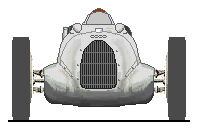
Long tailed variant. Closed suspension.
Avusrennen.
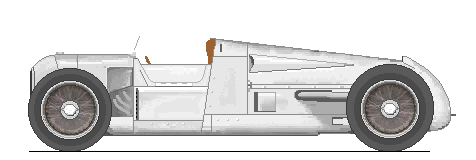 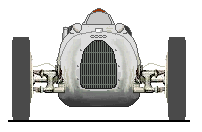
Early GP car, Eifelrennen. Car had black/white/red flag on left
side of tail, swastika in white circle on right side.

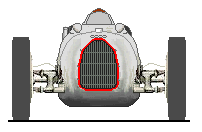  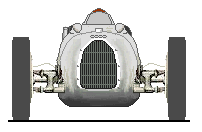
Without door, French GP.
Car had flag/swastika as in Eifelrennen.
Nose colors: Stuck (red), Leiningen (metal), Momberger (white)
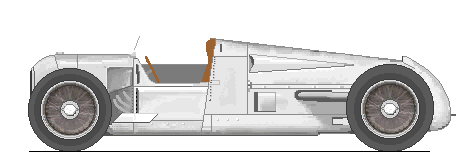 
Mountain climb car with fins behind front wheels.
Klaußenpaßrennen (Stuck)
 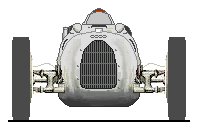
Upgraded GP car, with new air intakes & multitude of drilled holes.
German GP, Coppa Acerbo, Swiss GP, practice (Stuck, Momberger), Czech GP? (Sebastian)
 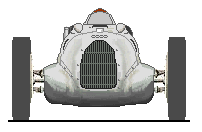
With closed in front suspension.
Swiss GP, race (Stuck, Momberger), Italian GP (Stuck, Momberger), Spanish GP (Stuck).
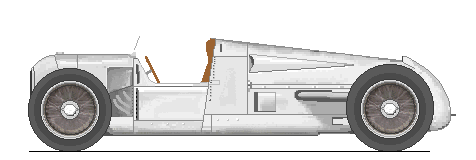 
With deep cockpit.
Spanish GP (zu Leiningen), Czech GP (Nuvolari, test)
 
With deep cockpit, closed in front suspension.
Czech GP (Stuck)
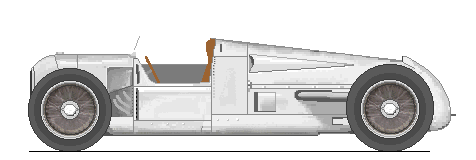 
Late chassis with straight cut side panel and with closed in
front suspension.
Swiss GP, race? (zu Leiningen), Italian GP (zu Leiningen)
 
Late chassis with straight cut side panel.
Swiss GP, practice ? (zu Leiningen), Czech GP (zu Leiningen)

October 1934 Avus speed record car.
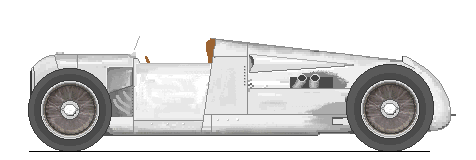 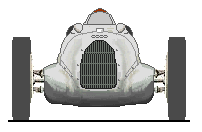
Tunis 1935. New high cockpit type. Still with reserve tank. No off-center refuelling shaft anymore.
No small air intakes. New type of exhausts. Closed in front suspension.

Lucca speed record car.

Lucca speed record car, enclosed rear wheels.

Speedlimousine, Avusrennen (zu Leiningen, Rosemeyer)
|

Auto Union 1935 ("B")
| Grand Prix 750 kg |
| Design: | Ferdinand Porsche |
| Engine: | V16 45° 68 * 75 mm = 4358 cc 2 valves/cyl, Roots supercharger |
| V16 45° 72.5 * 75 mm = 4951 cc, 2 valves/cyl, Roots supercharger, 375 bhp @ 4800 rpm |
| V16 45° 72.5 * 85 mm = 5610 cc?, 2 valves/cyl, Roots supercharger? |
| Transmission: | 5 speed gearbox |
| Chassis: | tubular frame |
| Suspension: | front: independent with trailing links, torsion bars, friction dampers |
| rear: longitudal torsion bars in frame side members, friction dampers |
| Dimensions: | wheelbase: 291 cm track: 142/142 cm weight: 805 kg dry |
| Year: | 1935, cars built : 4 new + 3 type A rebuilt |
For 1935 four new cars were built. Later known as the "B-type" the 1935 cars featured over 50 improvements including
new longer 105 mm chassis tubes. The cooling system was totally rebuilt with the frame no longer carrying water to the radiator.
The two tanks were replaced with a single 210 liter main tank behind the driver, meant to keep fuel for 320 km.
The engine had bigger valves and new cylinders, increasing compression from 7 to 8.95. Also added were an improved brake system, an improved gear box
and a new rear axle with torsion bars. At Avus new bigger engines with 72.5 mm bore were introduced. Some books have also mentioned
that a 5.6 liter variant was tested at the French GP, but I have been unable to confirm this.
During the season there were several changes to the cars. The new cooling system heated up the pedals and driver's feet so at the end of the season
the tubes were let out on the outside of the car on the right side of the cockpit.
It's my understanding that for 1935 cars recieved numbers with "1" as fourth digit (76011-76014 or 76012-76015) creating a gap in the numbering system
and fooling some historians to believe there had existed a huge number of chassis.
At the end of the season the team had 7 cars (corresponding to the three "A" + four "B" mentioned earlier) plus a hill climb special.
So where did the last one come from? Either a fifth "B" chassis was built during the season or then the fourth "A" was never scrapped as planned.
For 1936 four old cars were retained (probably the "B" types), two to be rebuilt as reserve cars and two to hill climb cars.
Victories:
1935 Race number checklist:
| | Stuck | Varzi | Rosemeyer | Leiningen | Pietsch |
| Tunis GP | | 34 | | | |
| Tripoli GP | 48 | 24 | | | |
| Avusrennen | 1 | 2 | 4 | 3 | |
| Eifelrennen | 1 | 2 | 4 | | 3 |
| GP de l'A.C.F. | 10 | 8 | 12 | | |
| Kesselberg* | 281 | | 2 | 3 | |
| GERMAN GP | 1 | 2 | 3 | | 4 |
| Coppa Acerbo | 37 | 39 | 30 | | |
| SWISS GP | 4 | 6 | 2 | | |
| Schauinsland* | 275 | 2 | | | |
| Selvio* | | ? | | | |
| ITALIAN GP | 12 | 22 | 30 | | 36 |
| SPANISH GP | 10 | 6 | 4 | | |
| Masaryk Circuit | 4 | 6 | 8 | | (2) |
| Feldberg* | 341 | | | | |
| Felsberg* | (288) | | | | |
Variants:
 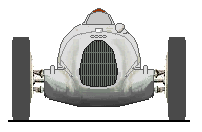
High cockpit. Closed in suspension. New exhaust type.
Only left side mirror. Avus GP (Stuck).
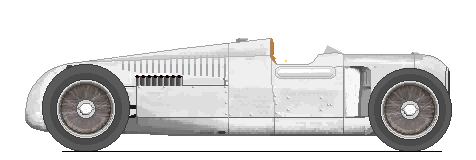
High cockpit. Open suspension. New exhaust type.
Only left side mirror. tripoli GP (Varzi).
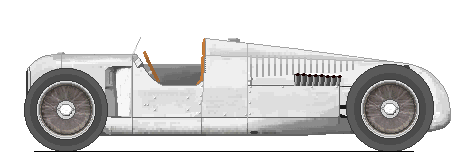 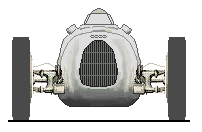

"Pukka" 1935 cars. Assymmetrical with high right cockpit side and low left side.
Mirrors are of a new type. Open suspension. Eifelrennen, French GP.
 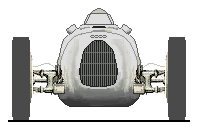
With air intake in front of the windscreen. Open suspension.
German GP, Italian GP. Rosemeyer red? around radiator at Italian GP.
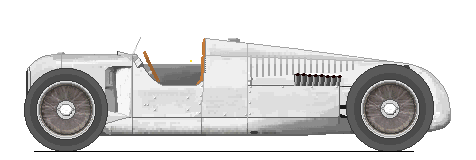 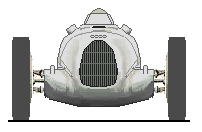
With air intake in front of the windscreen. Closed in suspension.
Coppa Acerbo. Several variants of windscreens/cockpits were seen during practice
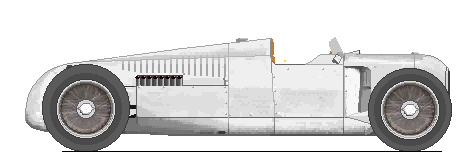
Coppa Acerbo practice, car #37. Note the windscreen and the panel.
Car #30 similar but with longer exhausts.
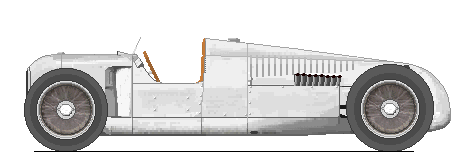 
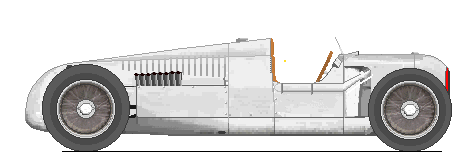
New type with exterior radiator tubes on right side of cockpit.
Open suspension. Spanish and Chech GPs.
|

Auto Union C
| Grand Prix 750 kg |
| Design: | Ferdinand Porsche |
| Engine: | V16 45°, 75 * 85mm = 6005cc, 2 valves/cyl, Roots supercharger, 520 bhp @ 5000 rpm |
| Transmission: | 5 speed gearbox, ZF differential |
| Chassis: | tubular frame |
| Suspension: | front: independent with trailing links, torsion bars, friction dampers |
| rear: longitudal torsion bars in frame side members, friction dampers |
| Dimensions: | wheelbase: 291 cm, track: 142/142 cm, weight: 824 kg dry |
| Year: | 1936-37 |
Later known as the "C-type" the 1936 cars featured a number of improvements including new rear supension and an enlarged 6 liter engine wih increases made in
compression ratio, supercharger pressure and r.p.m. The power was increased to 520 bhp while the greatest torgue 855 Nm was found at 2500 r.p.m. from earlier 650 Nm @ 3000 r.p.m.
Eight cars were built while of the seven old cars two were to be used as practice cars, two as hill climb cars and the fifth assigned for junior driver tests.
The last two old cars and the old hill climb car were scrapped and used as spare parts. That way Auto Union could have two teams of four cars plus a practice car used in turn.
As the formula continued into 1937 the C type was retained for that year.
Victories:
1936 Race number checklist:
| | Stuck | Varzi | Rosemeyer | Delius | Hasse |
| La Turbie* | ? | | | | |
| MONACO GP | 2 | 4 | 6 | (3) | |
| Tripoli GP | 32 | 10 | 46 | | |
| Tunis GP | 4 | 2 | 6 | | |
| Shelsley-Walsh* | 57 | | | | |
| Penya Rhin GP | | | 2 | 12 | |
| Eifelrennen | 2 | 6 | 18 | 11 | |
| Hungarian GP | 12 | 14 | 16 | | |
| Milan GP | | 54 | | | |
| GERMAN GP | 2 | | 4 | 8 | 6 |
| Coppa Ciano | 66 | 48 | 54 | | |
| Coppa Acerbo | (46) | 62 | 50 | 48 | |
| SWISS GP | 6 | 8 | 4 | | 2 |
| Schauinsland* | | | 84 | 82 | |
| ITALIAN GP | 2 | 6 | 4 | 8 | |
| Feldberg* | | | 61 | 62 | |
1937 Race number checklist:
| | Stuck | Varzi | Rosemeyer | Delius | Hasse | Fagioli | Müller | Nuvolari |
| South African GP H | | | 28 | 27 | | | | |
| Grosvenor GP H | | | 19 | 18 | | | | |
| Tripoli GP | 38 | | 16 | 22 | 6 | 12 | | |
| Avusrennen | | | 31 | 32 | 34 | 33 | | |
| Rio de Janeiro GP | 4 | | | | | | | |
| Eifelrennen | | | 1 | 2 | 4 | 3 | 5 | |
| Milan GP | | | | | 82 | | | |
| Vanderbilt Cup | | | 4 | 9 | | | | |
| BELGIAN GP | 8 | | | | 12 | (10) | 14 | |
| GERMAN GP | 10 | | 4 | 2 | 8 | | 6 | |
| Schauinsland* | 111 | | 116 | | | | | |
| La Turbie* | 1 | | | | | | | |
| MONACO GP | 4 | | 2 | | 6 | | | |
| Coppa Acerbo | 4 | | 10 | | | 20 | 22 | |
| SWISS GP | 10 | | 8 | | | 4 | | 6 |
| ITALIAN GP | 16 | 14 | 12 | | | | 18 | |
| Masaryk GP | | | 10 | | | | 14 | |
| Donington GP | | | 5 | | 6 | | 7 | |
Variants:


There appear to be two distinct types of cars, this one....


... and this, more common variant. Note the difference in the water pipe trunk.

High cockpit sides, 1937 AVUS.

1937 Vanderbilt Cup.
|

1936 races up to and
including the Milan GP |

Tripoli GP |
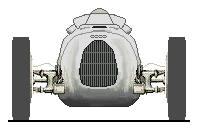
Hungarian GP |
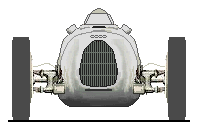
German GP
Coppa Ciano |
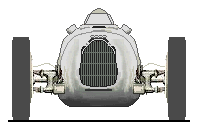
Coppa Ciano (Rosemeyer)
Coppa Acerbo |
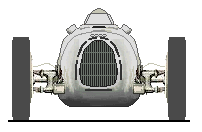
Swiss & Italian GPs |
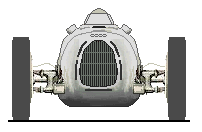
Most 1937 races |

1937 AVUS |
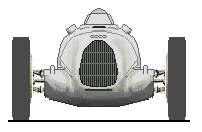
1937 Vanderbilt cup
Czech & Donington GPs |

C-type streamliner, Avusrennen 1937
|

Auto Union D
| Grand Prix 3 litre |
| Design: | Siebler, Eberan von Eberhorst, Strobel |
| Engine: | 1938: V12 60° 65*75 mm = 2986 cc, 2 valves/cyl, Roots supercharger, 420 bhp |
| 1939: Two stage Roots supercharger 485 bhp @ 7000 rpm |
| Transmission: | 5 speed gearbox, ZF differential |
| Chassis: | tubular frame |
| Suspension: | front: independent with trailing links, transverse torision bars, hydraulic dampers |
| rear: De Dion axle, longitudinal torsion bars, friction dampers |
| Dimensions: | wheelbase: 285 cm, track: 139/139 cm, weight: 850 kg dry |
| Year: | 1938-39 |
Victories:
1938 Race number checklist:
| | Stuck | Hasse | Müller | Nuvolari | Kautz |
| GP de l'A.C.F. | | 18 | (20) | | 16 |
| GERMAN GP | 4 | 6 | 8 | 2 | |
| La Turbie* | 22 | | | | |
| Coppa Acerbo | | 44 | 30 | 40 | |
| SWISS GP | 8 | | 4 | 6 | 2 |
| Großglockner* | 83 | | | | |
| ITALIAN GP | 36 | | 20 | 22 | 24 |
| Maloja* | 40 | | | | |
| Feleac* | 40? | | | | |
| Schulerau* | ? | | | | |
| Donington GP | | 2 | 1 | 4 | 3 |
1939 Race number checklist:
| | Stuck | Hasse | Müller | Nuvolari | Meier | Bigalke |
| La Turbie* | 20 | | | | | |
| Eifelrennen | 4 | 8 | 6 | 2 | (8) | 10 |
| Wien* | 183 | | 182 | | | |
| BELGIAN GP | | 4 | 6 | 2 | 8 | |
| Bucarest GP | ? | | | | | |
| GP de l'A.C.F. | 10 | | 12 | 8 | 14 | |
| GERMAN GP | 4 | 8 | 6 | 2 | 10 | |
| Großglockner* | 126 | | 125 | | | |
| SWISS GP | 8 | 2 | 4 | 6 | | |
| Belgrade City Race | (8) | | 8 | 4 | | (4?) |
Variants:

D-type streamliner, 1938 French GP practice

Rebuilt C-type
1938 French GP, German GP (Hasse, Müller), Coppa Acerbo (Müller)

1938 D-type

1939 D-type (Eifelrennen)

1939 D-type (Belgian GP)

D-type with 2 stage supercharger,
1939 (French GP onwards).
|
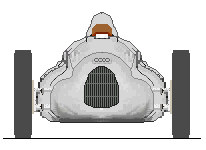
1938 |
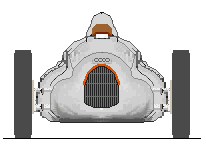
1938 Italian GP (Nuvolari) |
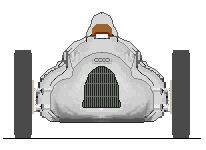
1939 |
|

